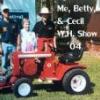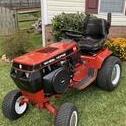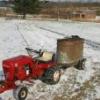Leaderboard
-
in all areas
- All areas
- Markers
- Marker Comments
- Marker Reviews
- Articles
- Article Comments
- Article Reviews
- Classfieds
- Classified Comments
- Classified Reviews
- Wiki's
- Wiki Comments
- Wiki Reviews
- Blog Entries
- Blog Comments
- Images
- Image Comments
- Image Reviews
- Albums
- Album Comments
- Album Reviews
- Files
- File Comments
- File Reviews
- Posts
-
Custom Date
-
All time
November 28 2011 - April 23 2025
-
Year
April 23 2024 - April 23 2025
-
Month
March 23 2025 - April 23 2025
-
Week
April 16 2025 - April 23 2025
-
Today
April 23 2025
-
Custom Date
01/21/2024 - 01/21/2024
-
All time
Popular Content
Showing content with the highest reputation on 01/21/2024 in all areas
-
14 pointsDent Parrett is not a household name but he improved the entire tractor industry While still in high school Dent Parrett began working with farm implements for Harry Van Horn, who had a implement store in Wenona Illinois. Van Horn let young Parrett repair and maintain the steam threshing machines he owned. A couple of Van Horn’s customers even had steam-plowing engines, and occasionally Parrett would get to work on them. In 1908, after spending a year at the University of Illinois, Parrett opened his own machine shop in Wenona. Parrett had been intrigued with the possibilities of a lightweight, maneuverable tractor for farm use in place of the clumsy steam-powered engines. In his machine shop, he began experimenting with a new tractor design. In his own words, ‘I hired a young engineer from the University of Illinois to work out the design details for the first tractor I built. This engineer was a junior and worked during his summer vacation to design the tractor; it was finished about the time he returned to school for the fall term.’ The first Parrett tractor was finished in time to help with the fall plowing in 1912. Encouraged by its success and the interest it stimulated, he organized the Parrett Tractor Company in 1913 at Ottawa, Illinois. Some thirty tractors were built there between 1913 and 1915. In 1915 the company was moved to Chicago Heights, Illinois, where over 300 tractors were built the first year, twice that number the next year. Massey-Harris Limited of Toronto, in 1916 already prominent in the farm implement field, was eager to add a tractor to its line. In 1917 an agreement was reached whereby Massey-Harris would build a tractor from Parrett’s specifications and drawings. Other companies, too, copied Parrett’s tractor so meticulously that some of the parts were interchangeable with those of the Parrett tractor. To prove how reliable the Parrett tractor was, Dent Parrett put on a 100-hour non-stop demonstration near Salina, Kansas, during one of the national tractor demonstrations. Parrett’s machine pulled binders in the wheat field. It thoroughly demonstrated that while the Parrett tractor could operate non-stop, the then-current horse drawn binders with tractor hitches couldn’t and went to pieces like wooden bridges under the big steam rig. Parrett was the first to solve the dust hazard for gasoline-driven farm equipment, when he came up with a water filter cleaner, which was later standard equipment on farm machinery. In 1918, Parrett was commissioned a captain in the ordnance reserve corps, in charge of engineering production and inspection of engines and artillery tractors built by Holt Manufacturing Co. of Peoria, Illinois, which after the war became Caterpillar. By 1919 there were about 200 firms trying to get rich making tractors, and with Dent Parrett having to pay almost as much for an engine as Henry Ford got for his whole tractor, Parrett sold off his enterprise and took to designing for other folks. Massey-Harris hired Parrett in 1920 to design a larger tractor than the earlier model and to supervise the building of experimental tractors from his new designs. From 1920 to 1923 he was chief of experimental design at Massey-Harris. In 1923 he designed a light-cultivating tractor, later produced by Continental Cultor of Springfield, Ohio. Parrett used a Ford engine in this tractor… and became a close friend of another imaginative pioneer in the automotive field, Henry Ford. This light tractor sold as part of a complete cultivating unit. One model pulled a single-row cultivator with the operator in the cultivator seat guiding the tractor. Another model had the cultivator mounted on the tractor. Several thousand of these cultivating units were sold. He also designed, for Continental, a mounted corn picker the first quickly mountable picker ever produced commercially. In 1931 a tractor he produced for Sears Roebuck went out to the Nebraska Tractor Testing facility and pulled (on steel wheels, of course) within 10 pounds of the operating weight of the tractor plus, the operator, oil, water, lugs and all. It was a world’s record that has never been beaten or equaled. The Parrett-designed rubber-tired tractor hit the market about the same time in 1932 as one built by Allis Chalmers with Firestone tires. Records aren’t clear on which tractor can claim the honor of being first, but it was obviously a pretty close race. Parrett in 1938 became associated with Auto Specialties Manufacturing Co. in St. Joseph, Michigan, to work out an adaptation of a disc brake for tractors. Evolving out of this assignment was the Parrett-designed double-disc brake now standard on about half of the wheel-type farm tractors built in this country. In 1946, also for Auto Specialties, he developed a high-capacity clutch that could interrupt the power to the final drive pinion to give the tractor live power take-off. With very little basic change in tractor design, thousands of these clutches are in use today. Parrett had enough patents to wallpaper his home on Lake Michigan, though he didn't actually do that. Also added to the list of achievements must be an item to cover the inspired leadership Parrett has given to two young engineers fortunate enough to work with him. One of these went on to become chief engineer at Ford Motor Co. and another became chief engineer with Allis Chalmers Manufacturing Co. He was the recipient of the Cyrus Hall McCormick Gold Medal from the ASAE for his work on the Lambert disc brakes and his high-capacity clutch.
-
8 pointsI have no photos of this but when I was about nine or ten years old my father bought a new rotary mower and let me play around with the engine from the old reel mower. I built my first ride! I took an old chicken coop door, a couple of 20" bicycle tires and wheels for the rear, a couple of wheelbarrow wheels and tires on the front axle and an old chair with no legs for a seat. The front axle was a 2 X 4 with some steel round stock nailed to it and a bolt in the middle connecting it to the chicken coop door. For steering I had a piece of clothesline nailed to the 2 X 4 at each end. There was no clutch, just a direct chain drive from the engine to the drive wheel. I just propped the rear end up off the ground and once the engine was started I would sit down, pull on the wire attached to the throttle, rock MY FIRST CAR forward until it fell off the block under the rear and off I would go. I have no idea how fast (or slow) I was going but it seemed like I was on a race track. I never put any brakes on it, just let of on the throttle wire and the engine would stall. It wasn't the fanciest car I've ever owned or the best one but it was without a doubt the most memorable.
-
7 pointsWith sub zero temps last weekend I did not bother heating up the garage to do any work. Had other engagement's yesterday but today I was hard at it again. First on the agenda was to raise the fender up to gain some more clearance for the tires. The hinge/riser was busted loose from from the fenders, so I only had to break the spot welds loose on one side. Once broken loose I replaced the broken cross piece, cut the 90 degree bend off from it and added a new piece to raise the fenders up 1/2". Drilled holes in the added on pieces so that I could blind weld the the hinge back on to the fender. This gave me good clearance between the tires & fender. With this done it was time to break down the tractor to fit the next piece. The next piece is a reinforcement that I made for the F-plate. The F-plate on this tractor is not cracked & I hope to keep it that way despite the abuse that I plan on putting it through. The side plates of this reinforcement are made out of 7ga metal. The plate that bolts against the F-plate is 1/4" plate. Reinforcement bolted in place. With these alterations done I fit things back together so that I can move on to the next fitments. My new front tires came in so I was able to mount them on the rims and set the tractor down on all 4's. So far I like the stance that I have with a lower front axle and the 6" wheels. Now that I have it on the ground I can start measuring things up for the adjustable hitch and wheelie bars.
-
7 pointsJust found the ‘Manual’ version valve lapping tool I mentioned before. Made by ‘ZIM’ manufacturing co. Chicago, USA! The shaft oscillates as you turn the handle. It even has a thrust bearing at the top of the shaft! I think it also came with another shorter shaft? Anyway, here are the pics I promised, I know how much you all love ❤️ pics!
-
7 points
-
6 pointsD160 lacked power and kind of problematic but was a survivor, tossed it up on the bay and it went out West. My Rhino was a real beast was chipped and would get. Trail rode a lot. Arthritis set in and couldn't take the beating anymore. Sold it to some kid up North. He was tickled to death. SRT8 Magnum 1 of 256 Wife took it out one day, she came back and the car didn't 13000 miles on it. I remember me and the boy was on the interstate, Christmas morning, dry cool out, going to see a relative in the hospital. He was driving and there was no traffic. I told him let her stretch her legs. He let off at 149 and I told him you had one more gear. He looked at me and said, "but I am out of nuts" good memory.
-
6 pointsThis old Ford has always been my favorite. I guess that is why I still own it. Lots of family history in it. And yes the dozer too.
-
5 points
-
5 points
-
4 pointsAs we get older and not necessarily grown up do you sometimes wish you could open the garage or barn door and hop in or on something that you seriously would like to enjoy again , but maybe not feasible ? Post up some pictures if you have them or a description of it. Here are a few from my past.
-
4 pointsA few years ago I had a customer mower, shaft driven deck...that had a gearbox with a female square pipe plug and it wasn't 1/4, 3/8, or 1/2"...the kit with male and female was cheap enough on ama zon, so i got it. While removing my 702 hubs today i was adjusting my vice grips and thought Hey Wait...sure enough i had one that fit.
-
4 pointsTook a quick spin in the woods today…needed some seat time therapy. 315-8
-
4 pointsThanks for making this connection. Since the spark happens when the points OPEN and a larger gap opens sooner, it advances the timing.
-
4 points
-
4 points
-
4 pointsWhen you've messed around with few broken down blowers in the middle of the snow removal process and freeze the nads off doing it, you tend to remember every little detail to get them ready in the fall while it's still warmer. My first blower was a beat up neglected POS so it required just about everything to be fixed or serviced that first year.
-
4 pointsAgree that added weight - in or on the wheels / tires is a better choice than comparable weight added to the frame / hitch. I use 2 link chains, fluid filled tirea and 95 lbs of cast weights - all as described above.
-
4 pointsThanks for the "mention" Brooke... Here's the link. We put this list together for a list as concise and complete as possible. It covers several decades. Do read it over... a few times. On your tractor. My opinion? Get it running and driving. Use it. Adapt to it. Improve on the ways it can help you. These machines aren't disposable. They're equipment. A permanent part of our arsenal. Definitely keep asking questions.
-
4 pointsWould have to be a mini bike I had around '75 - '76. A five horse horizontal Briggs with a custom exhaust. Rebuilt the motor in HS power mechanics shop. What a blast! Close second would be a 1980 Ford F-150 step side I bought brand new when I made petty officer third 1979. 11,000 Washington's in the day. May have pics of that will have to dig out. Good thread Plunge 👌
-
4 pointsI have no idea if this is all true or not. Stole it off FB but thought interesting. This photo below is a Tesla model Y battery. It takes up all of the space under the passenger compartment of the car. To manufacture it you need: --12 tons of rock for Lithium (can also be extracted from sea water) -- 5 tons of cobalt minerals (Most cobalt is made as a byproduct of processing copper and nickel ores. It is the most difficult and expensive material to obtain for a battery.) -- 3 tons nickel ore -- 12 tons of copper ore You must move 250 tons of soil to obtain: -- 26.5 pounds of Lithium -- 30 pounds of nickel -- 48.5 pounds of manganese -- 15 pounds of cobalt To manufacture the battery also requires: -- 441 pounds of aluminum, steel and/or plastic -- 112 pounds of graphite The Caterpillar 994A is used to move the earth to obtain the minerals needed for this battery. The Caterpillar consumes 264 gallons of diesel in 12 hours. The bulk of necessary minerals for manufacturing the batteries come from China or Africa. Much of the labor in Africa is done by children. When you buy an electric car, China profits most. The 2021 Tesla Model Y OEM battery (the cheapest Tesla battery) is currently for sale on the Internet for $4,999 not including shipping or installation. The battery weighs 1,000 pounds (you can imagine the shipping cost). The cost of Tesla batteries are: Model 3 -- $14,000+ (Car MSRP $38,990) Model Y -- $5,000–$5,500 (Car MSRP $47,740) Model S -- $13,000–$20,000 (Car MSRP $74,990) Model X -- $13,000+ (Car MSRP $79,990) It takes 7 years for an electric car to reach net-zero CO2. The life expectancy of the battery is 10 years (average). Only in the last 3 years do you start to reduce your carbon footprint, but then the batteries must be replaced and you lose all gains made. But by all means, get an electric car. Just don't sell me on how awesome you are for the environment. Or for human rights.
-
4 pointsMiss my 1970 Impala and my 1978 H.D. Super Glide. No digital pictures of either one.
-
4 pointsThe larger the diameter of the muffler, the better resonation it will have. Suppressing the sound better. A larger tail pipe from the muffler will produce a lower tone as well.
-
4 points1972 Fabuglass with a 60 Johnson. Pic of me and Dad who passed 1 year ago at 95. We had the boat 49 years... IMG_7921.mov
-
4 pointsPut the Ber Vac to work this AM. 14F outside and 40F in the cab. Two hours later....back in the barn.
-
4 points
-
3 pointsHello, I'm new to the group. Thanks for the addition and expertise. I picked up an Electro Charger 12 today. It was the tractor I learned and rode with my father as a boy so I'm looking forward to revitalizing it. I'm asking a broad question 1st of any suggestions or advise everyone has to bringing an old Wheelhorse back to life. What would you say are "must do's / don'ts?" What did you wish you knew before you started your own rebuilds? What did you spend too much time on and wish you had put the energy in elsewhere? From what I have found so far the machine is in great shape for its age. Always kept indoors, does not seem to have and significant wear even looks to be original paint underneath some surface greese which likely help keep it preserved. The tires, seat, wheels all appear to be original as well with no cracks our dry rot. It's a Kholer K301 S motor. So far I've purchased a new spark plug, Kholer 10W30 oil. Oil, fuel and air filters. A can of Seafoam, a new muffler and an owners manual from Ebay. Am I missing anything? I'm going to take a close look at the transmission fluid. I've read this is both transmission and hydro fluid for the Tractor located under the seat. Is this a good fluid to use Amazon.com: Castrol 03520C TRANSMAX DEX/MERC ATF, 1 Gallon, Automatic , Black : Automotive What transmission filter is best? My Tractor seems to have an extra pull switch on the dash too. (Photo attached) can anyone tell me what it's purpose is? Really excited for this project and glad for a resource like tis forum. Thanks in advance, Brooke
-
3 pointsI bought a snow blade maybe 8 years ago and it had an additional front mount bracket that attached to the front mule bracket mount it seems like a great idea to help keep the side to side pressure under control,was wondering what model the plow was made for and if anyone else knows about this ,I have two tractors with plows one for snow work and one for dirt and gravel I have no pictures of the original bracket on the snow machine but I made a close copy for the dirt plow and am sending pictures of it curious of thoughts and comments
-
3 pointsThis is why I recently bought a 418-8 with electric lift. Eventually it will be my dedicated tiller tractor, after I install the rear rockshaft. I’ve always tilled with a hydrostatic transmission. I think the 18HP 8-Speed with electric lift is going to be a great combo for tilling.
-
3 pointsWe brought the Millie tractor in the basement workshop for some repairs and maintenance. Diagnosis on no-start or stall condition. Change ALL fuel line and filter. (The clear blue line was hardening too quickly for my satisfaction). Increase upper RPM limit. Determine cause of generator lamp dysfunction as per last post.
-
3 pointsLiterally, skied through the trees... For years when we skied with the kids I would ski ahead and ski through a tree... it was great fun until they got old enough to figure it out... I still do it to amuse Mrs Sylvan...
-
3 pointsThe only one I know of that WH made was on the XI machines, It used a peg and hole. The mule drive on the xi machine goes in horizontal, so there is no side pressure on the latch. I made a few like the one you have and they work great. If you other one is working well on the dirt blade I call it a win. If you wanted to reinforce yours a second set of connecting bars would help. Using a peg and hole one on the vertical mule drive arrangement does put the stress on the latch. Just a note. WH factory xi stabilizer this one I came up with that is similar to yours. And I can drag the front end of the tractor over by the plow.
-
3 pointsI have a few sets of 8 point and pipe plug sockets. Need both internal and external though. Work great
-
3 points
-
3 pointsThanks for all your help. Love the quote nothing runs like a deere when it is chased by a horse.
-
3 pointsGreat idea- to start testing tractors… Probably squelched a lot of those outlandish claims concerning a certain brand of green and yellow tractors…
-
3 points
-
3 points
-
3 pointsAlways like to see a great old getting some love by a second generation owner. The Electros and Chargers are great garden tractors and with wheel weight and chails it will push a lot of snow. Having the hydraulic lift for the snow plow is a big plus. Enjoy the ride and please ask any questions that may come up. In my opinion I wouldn't even consider painting or replacing anything, The Electro has seen decades of TLC during your father's ownership and you don't want to cover that up with any fresh paint. A bit of elbow grease with some 4-O steel wool and WD-40 will remove the rust and bring back the color. I was wondering about that too. Engine Spec. number is correct for a 1969 Electro, perhaps a very early production unit when the transition from S/G to engine mounted starter took place.
-
3 pointsNo no no... They're just trying to tell you that you are number 1!!! If they use both middle fingers you're really Number 1!!!
-
3 pointsI wasn’t going to get involved in this conversation but now I want to make a few counterpoints… I have no desire or ability to suss out whether those Facebook facts are true or not Jim, but I am suspicious of them. Full cost accounting is hard to do and the results are highly dependent on where a person decides to draw the boundary conditions. The conclusions always seem to follow the bent of the publisher. I’m sure I could craft an example that will show EVs will save us from ourselves and get us back to our high-school athlete physiques. When it comes to EVs there are two big camps: The pros and the antis. There aren’t very many small tents outside the periphery. This makes it hard to know what is fact and what is crap. I put myself in one of the small tents. I don’t care whether you buy a Bolt or a Duramax as I can see the value in both. The preponderance of information I see floating on social media and in (mostly conservative) media outlets usually looks to be lists of specious facts. Usually a lot of important details are omitted in these stories. What I see presented on the acolyte side is typically idealized and dismissive of the realties of EVs not being suitable for every person or every application. For whatever reason, both sides seem flummoxed by how these things actually work and that there are nuances to all vehicles. In the data above for instance, the Tesla Model 3 and Y are similar cars built on the same platform. They share a lot of components. I think the batteries and motors are either identical or very similar. To see such a gap between their battery pack replacement costs is suspicious and suggests at least one of them is wrong. I see a lot of mentions of batteries only lasting 10 years. In reality - with some well-publicized exceptions - they are lasting much longer. Many are warrantied for ten years. I suspect we are conflating that the manufacturers are required by the federal government to warranty the battery for 8 years or 100k. If they were to only last 10 years in any appreciable quantity we’d see statistical variation forcing a lot of warranty replacements at or before the 8 year mark. It’s not happening. The Model S was released in 2012. There are still plenty of these on the road with their original batteries. And they are apparently not experiencing the massive degradation many (including me) predicted. Yes, there are those that caught fire on the drive home from the dealership, but I didn’t have to look too far to see they are typically holding on to 85+% of their capacity at 200k miles and ten years. That’s pretty good considering everything in every car - gas or electric - degrades over time. When the batteries are spent they aren’t landfilled in any kind of significant quantity. The expense and effort taken to mine the materials that go into them means that the stuff inside them has intrinsic value. EV batteries are too precious to throw away and the recycling stream for these is somewhat in a nascent stage but it is robust. Tesla in fact has a recycling loop already in place and claim to recycle nearly all of their batteries when a car is at the end of its road. Not that we should believe all of Tesla’s claims. I don’t know where we are on this stage of things, but one of the plans for EV batteries that are aged beyond the point where they are good enough for vehicles is for stationary storage. The weight and capacity vs size trade offs aren’t nearly as big of a deal for stationary use. there they can live on for another decade or more, quietly pushing power back and forth. Hertz selling off their Tesla and electric fleet doesn’t seem as newsworthy to me as many outlets are making it. These are cars that have 80000 or more miles on them. At average rental rates and miles driven they have probably grossed at least $40000-$60000 in revenue from each car. Most articles point to nebulous “repair costs” for the cars so the inference is that the EV systems are troublesome, but in actuality it was apparently repair costs associated with collision damage. Plus, the bizarro infotainment and driver control system Tesla uses makes it hard for customers to get acquainted in a short time, couple that with unfamiliarity with charging and I suspect customers are generally not fans. And in a business where the rental company has their customers fuel their fleet or pay an extravagant fee to leave them under-filled it probably is comparatively costly juicing them up at the rental garage. The wintertime charging blues are a reality. Probably helped along by a dose of operator error or inattention here and there. The cars precondition their batteries to make them receptive to charging and it seems this wasn’t executed in some instances. I find it frustrating that the drop in range in an EV due to cold temperatures is attributed solely to efficiency loss. While that’s partially true (increased rolling resistance, slowed battery kinetics, etc.) that’s not the whole story. In an engine powered car a portion of the waste heat produced by burning the fuel is used to heat the cabin. In an electric car there is very little waste heat and none of it is available to heat the occupants. So battery energy has to be turned into heat. And, unfortunately, it takes a tremendous amount of heat to keep a car interior warm when it’s hurtling through the icy air at 60 mph. The electric heaters (and heat pumps) can consume 3000w of heat to maintain temperature and thus are quite impactful on range. But what about The Grid? It’s a problem. As a society we have been coasting along with cheap fuel-fired power for decades. Since we’ve had plenty and it was cheap, there was little impetus to upgrade anything or buttress against growth or insecurity. Out of sight, out of mind. The relative distaste for growing a coal plant or nuke in your backyard had meant we’ve avoided putting power plants where we need them. That’s not completely unreasonable. Anyway, we find ourselves today with a power grid that usually can cover our daily needs but due to growth of electrical demand in general, aging infrastructure, and slow growth in renewable power we have challenges. If the whole vehicle fleet were to transition to electricity there isn’t enough power to go around. But we have a couple of things going for us. First, the grid generally is undertaxed at night. So there is actually more capacity available to charge electric cars than we realize. One of the dreams is to make the battery in your EV a bidirectional unit that can be filled up at night then partially drained back into the grid when the car is sitting there doing nothing while you’re at work. Yes, there are issues with this, but not so complicated that it can’t be figured out. Second, increased demand will - and has been - doing what it does in a capitalistic society: spurring opportunities to make money. These opportunities mostly come in the form of increased development of renewable power, but could manifest in other ways too. Battery storage comes to mind. Pumped hydro is another. Either could help smooth the boom and bust of the daily grid fluctuations. It’s gonna take more generation, for sure. But it’s not as bleak as it seems if you think in terms of integrated systems. Nuclear seems like an easy solution since it’s proven. There isn’t an infinite supply of fissile material so it’s not a forever solution either, but it has a lot of potential. Thanks to some rational fears and a healthy dose of scientific and technical ignorance we don’t have a large appetite for new nukes in the US, but I see a huge opportunity for Mexico to be a power exporter to the US. Shoot, if they built enough power plants they could sell us power and have enough capacity to desalinate water for the parched American West. Opportunities abound. I used to think EVs were a solution looking for a problem, but the more I read the more i am coming to realize they make a lot of sense. I would consider one for my next car, especially while their operating costs are so low compared to a gas vehicle. we also seem to be holding EVs to a much higher standard than we do everything else. If we flipped the script and were looking to replace our 100-year entrenched fleet of electric cars with gasoline powered cars I could imagine the friction then… You expect me to stop at a filling station and pump 120 pounds of explosive liquid into a thin sheetmetal tank under the kids’ child seat in the back? You mean I have to change the oil every ten thousand miles? I have to wait for the engine to warm up in the winter before I get any heat in the cabin? Why are those things so loud and why are they so slow? How come it has to shift so many times instead of just accelerating smoothly? Wait a minute, you mean I can’t recover any energy when I come to a stop or coast down a hill? And, to top it all off, who came up with this system where barely 1/3 of the gas I buy goes into moving the car while the other two thirds are left in my wake as waste heat from the radiator and exhaust? It would be bedlam. steve
-
3 pointsIts a good positive fit, no chance of slippage even on these old bolts
-
3 points
-
3 points
-
3 pointsWorm gear and the chute were giving me a fit, drifting past the teeth - Toro is proud of their parts - 27 each for guides 7 each for the " special " screws according to them - I measured a screw it's basically a #10 x 1" hex head self tapping sheet metal screw - ordered a box of 50 stainless for 10 bucks - the spring washer and flat behind the worm gear are both shot - for now I added a nylon washer behind the spring washer to keep it centered - have stuff on order to get this right
-
3 pointsPull switch was for the original electric PTO clutch.. obviously replaced over the years with a manual PTO clutch. Any Dex/ Merc automatic transmission fluid will be fine. (Just make sure the fluid in her is red) Wix 51410 is a good filter. I have a few Electro/Chargers ..love them!!! Under the instrument panel (next to the blue arrow) is a data plate what is your model number.? The pulley on the engine indicates it may have had a Starter generator at one point ... also you have a Breakerless ignition system They work well but never ever let voltage get to the wire on the bottom of the coil (triangular thing front left of engine...) I hate to comment on oil but if you are not going to be using her in the winter straight Rotella 30w is my choice for winter 5w-30
-
3 points1) Extension flaps are on upside down 2)There's no idler pulleys for proper belt tension. (Belt will hold that thing up) 3) Those straight type mounting arms are from a smaller lawn ranger - Not curved up. But hard to tell if it's a problem because the that entire mount with the chute was changed 4) The lift mount is to the left side and not in the middle (Although it probably still works) 5) Shaft is a bit long but shouldn't interfere 6) Someone tried to modify a blower that didn't really succeed
-
3 points
-
3 pointsHave had plenty of stuff over the years but no pics. VW engine powered dune buggys were a lot of fun. I used to tow one with my VW bug and if the buggy broke down then take the bug into woods and beat on that for a while. 250R Honda ATVs and misc dirt bikes. Boats
-
2 pointsToday I mounted the weight box on my 418-8, and built a wooden insert so I can fill it with concrete. Then bent some 3/4” round stock to sink into the concrete for a handle to lift it out. Next I jacked up the rear tires to install tire chains, that’s when I noticed that the hubs were loose. So off came the wheels and that’s when I realized that now was probably the time to also address the slightly leaking brake drum seal! When I bought this tractor I remember tightening the set screws on the hub. Now since they are loose again I guess I’ll replace them. Good news is that I think I have the seal in stock! I ran out of gas for the day, tomorrow is another day!! Here’s a few pics.
-
2 points1963 Chevrolet Impala SS ,327 ,4 on the floor. I was 18. Back in the stone age.

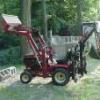
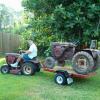
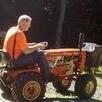


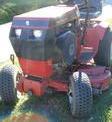
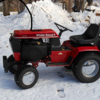









.thumb.jpg.7a4e25552dfae5ebd8fc449880c1e864.jpg)
